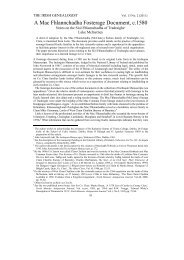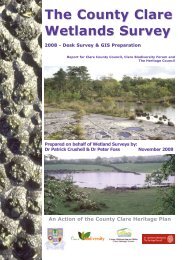Documents from the Thomond Papers at Petworth House Archive1 ...
Documents from the Thomond Papers at Petworth House Archive1 ...
Documents from the Thomond Papers at Petworth House Archive1 ...
You also want an ePaper? Increase the reach of your titles
YUMPU automatically turns print PDFs into web optimized ePapers that Google loves.
Archivium Hibernicum<br />
O’Meere’s complaint referred to his family (Uí Mhaoir) being tenants on<br />
<strong>the</strong> termon lands prior to <strong>the</strong> original lease made to <strong>the</strong> Bishop of Kildare. 55<br />
The claim by O’Meere was launched as a suit <strong>at</strong> <strong>the</strong> Chancery Court<br />
probably under <strong>the</strong> auspices of <strong>the</strong> Earl of <strong>Thomond</strong> but was dropped<br />
when <strong>the</strong> earl and Bishop of Killaloe reached an agreement, presumably<br />
leaving O’Meere without recompense. 56<br />
Two o<strong>the</strong>r documents concerning alleged dispossession of freeholders’<br />
land by <strong>the</strong> fourth earl of <strong>Thomond</strong> can be profitably investig<strong>at</strong>ed. A<br />
petition <strong>from</strong> 1622 by Owen O Mallouny (PHA Ms 3193, 3194) th<strong>at</strong> he, being<br />
a ‘poor man’, had as his demesne <strong>the</strong> half plough lands of Ballybrukan<br />
(Ballybroughan, Kilfintinan parish). In his appeal to <strong>the</strong> Lord Deputy he<br />
asked to be admitted as ‘forma pauperis’ and be appointed legal counsel<br />
in order to pursue his claim against <strong>the</strong> earl. A largely illegible letter<br />
entitled ‘<strong>the</strong> answer of Owin O Mullowny’ (PHA Ms 3194) notes th<strong>at</strong> <strong>the</strong><br />
aggrieved st<strong>at</strong>e of <strong>the</strong> petitioner, Owen O Mallouny, and th<strong>at</strong> ‘he will go to<br />
any summary counsel before <strong>the</strong> Judges’ and, in <strong>the</strong> opinion of <strong>the</strong> author<br />
of <strong>the</strong> letter which was probably an official of <strong>the</strong> Lord Deputy, O Mallouny<br />
was ‘purposely sett [sic] on to <strong>the</strong> claim, having one with case’.<br />
Appeals to <strong>the</strong> Lord Deputy and <strong>the</strong> Court of Equity by Gaelic freeholders<br />
seeking redress was noted by German settler M<strong>at</strong><strong>the</strong>w de Renzy who<br />
was surprised <strong>at</strong> <strong>the</strong> tenaciousness which freeholders pursued legal cases, 57<br />
unsurprising given <strong>the</strong> high stakes involved in pursuing claims against<br />
titled magn<strong>at</strong>es such as <strong>the</strong> earl of <strong>Thomond</strong>, who is aptly referred to<br />
in Owen O Mallouny’s petition as ‘a mighty adversary’. 58 It appears th<strong>at</strong><br />
Owen O Mallouny was successful in his petition as an ‘Owen O’Molowney’<br />
was recorded proprietor of Ballybroughan and Kilmacreagh in Kilfintinan<br />
parish in 1641. 59 A similar petition concerning dispossession of John<br />
55 The relevant section reads: ‘O’Meere in <strong>the</strong> bill mentioned seised in his demesne unto him<br />
<strong>from</strong> his ancestors of <strong>the</strong> said town and lands,’ Ibid.<br />
56 Rev. Philip Dwyer, The Diocese of Killaloe <strong>from</strong> <strong>the</strong> Reform<strong>at</strong>ion to <strong>the</strong> Eighteenth Century,<br />
p. 329. On a different view on <strong>the</strong> P<strong>at</strong>rick O’Meere case see Dermot Gleeson, ‘The P<strong>at</strong>ron<br />
Saint of Dromcliffe’ in Molua (1958), p. 47. Also see <strong>the</strong> Chancery Pleading by supplicant<br />
P<strong>at</strong>rick O Meere which mentions th<strong>at</strong> <strong>the</strong> supplicant’s fa<strong>the</strong>r, [Donogh] ‘was thrust out<br />
[with]…his family’ by <strong>the</strong> commandment of Donough O’Brien, fourth earl. See Chancery<br />
Bills: Survivals <strong>from</strong> pre-1922 Collection, [G1] [und<strong>at</strong>ed] (N<strong>at</strong>ional Archives, Dublin).<br />
57 Mary O’Dowd, ‘Gaelic Economy and Society’ in Ciaran Brady & Raymond Gillespie (eds),<br />
N<strong>at</strong>ives and Newcomers: Essays on <strong>the</strong> Making of Irish Colonial Society 1534:1641, (Dublin, 1986),<br />
pp 120–147, p.142. De Renzy was born in Cologne in 1577 and worked as a cloth merchant<br />
in Antwerp until he moved to London around 1604. He reloc<strong>at</strong>ed to Ireland in 1608 where<br />
he lived for some time with <strong>the</strong> Mac Bruaideadha historian-chroniclers in Co. Clare <strong>from</strong><br />
whom he learnt Irish. In this respect, he was <strong>at</strong>ypical of most planter families given his<br />
engagement with Gaelic liter<strong>at</strong>i lineages such as Clann Bhruaideadha. See Brendan Ryan,<br />
‘A German Planter in <strong>the</strong> Midlands’ in History Ireland, viii, 1 (Spring, 2000), pp 7–8, p. 7.<br />
58 (PHA Ms 3193). The section reads: ‘[<strong>the</strong>] petitioner is a poor man unable having no means to<br />
sue his said land against such a mighty adversary and for th<strong>at</strong> also he was <strong>the</strong>reof unlawfully<br />
dispossessed’ [spelling modernized].<br />
59 R. Simington, Books of Survey and Distribution [Vol. 4, Clare], (Dublin, 1967), p. 179.<br />
16

















